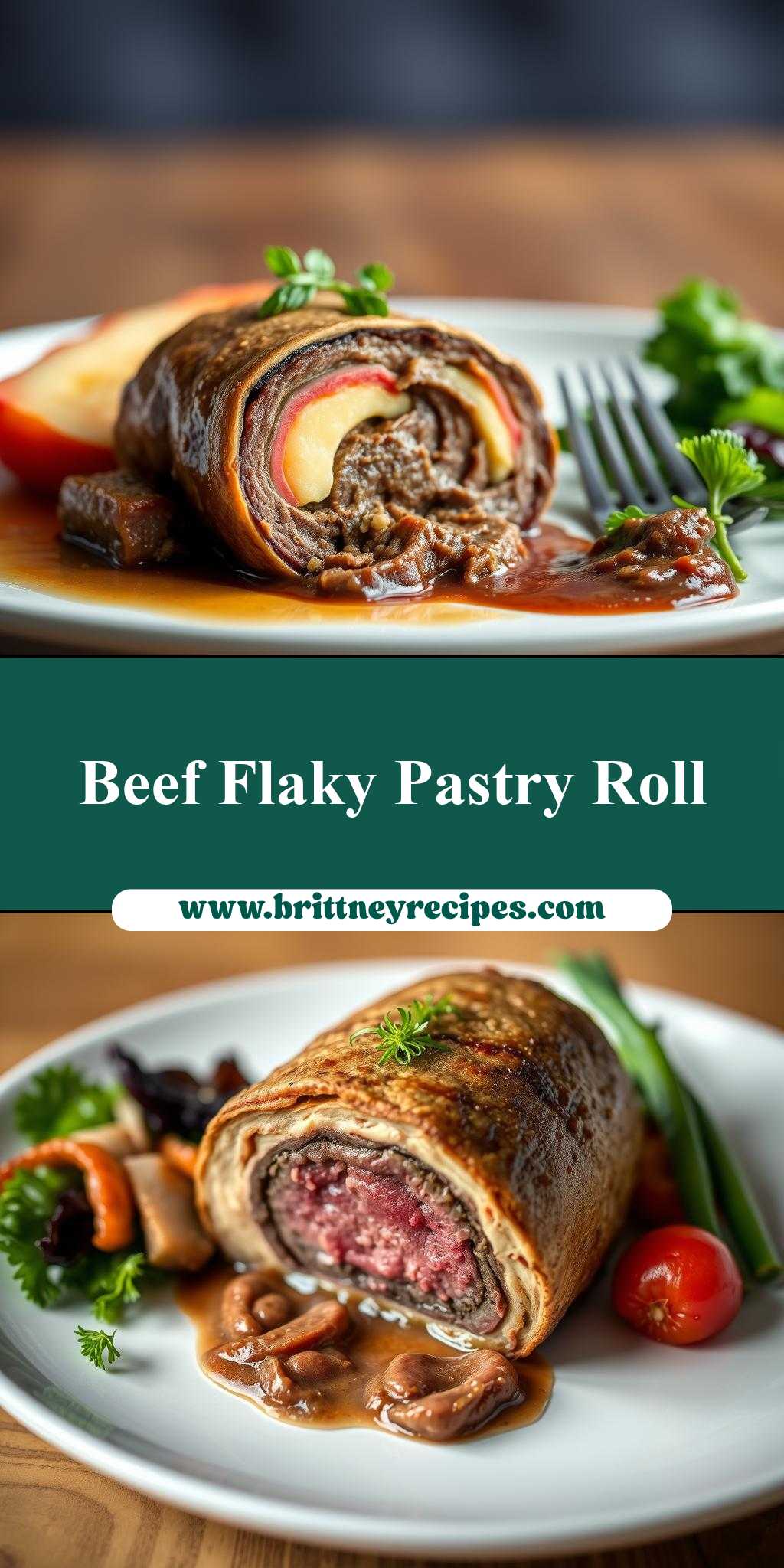What makes a show stopping main course like Beef Wellington so impressive when its actually pretty straightforward to make at home with just puff pastry and tenderloin. This easy homemade version is a weeknight dinner game changer that uses simple prosciutto wrapping for added flavor. Save this idea for your next family favorite meal.
Beef Wellington
Introduction
Imagine a dish so elegant, it’s perfect for special occasions, yet so approachable, you can make it on a whim for a fancy dinner at home. Beef Wellington is that dish – a show-stopping, flavorful masterpiece that combines tender beef, mushroom duxelles, and puff pastry in a harmonious union. The beauty of Beef Wellington lies not only in its impressive presentation but also in the ease with which it can be prepared, using everyday ingredients that are both accessible and affordable. Whether you’re a seasoned chef or a culinary novice, this recipe is designed to guide you through the process with clarity and simplicity, ensuring that your Beef Wellington turns out nothing short of perfection.
Why This Works
- Flavor balance and ingredient accessibility: The combination of beef, mushrooms, and puff pastry creates a balanced flavor profile that is both rich and light, making it appealing to a wide range of palates. The ingredients are readily available in most supermarkets, making this dish highly accessible.
- Ease of preparation: Despite its sophisticated appearance, Beef Wellington is surprisingly easy to prepare. The steps are straightforward, and with some basic kitchen tools, you can achieve professional-looking results.
- Impressive results with minimal effort: The dramatic presentation of Beef Wellington makes it an ideal choice for entertaining. The puff pastry crust adds a luxurious touch that is sure to impress your guests, all with relatively minimal effort compared to other dishes of similar caliber.
Key Ingredients
The main ingredients in Beef Wellington include a filet of beef, mushroom duxelles (a mixture of sautéed mushrooms and herbs), puff pastry, and a variety of spices and seasonings. For the beef, a tender cut such as filet mignon is ideal. The mushroom duxelles can be made with a variety of mushroom types, including button, cremini, and shiitake, and is seasoned with thyme, rosemary, and garlic for added depth. Puff pastry, which can be found in most grocery stores, provides the flaky, buttery crust that envelops the beef and duxelles. Practical substitutions can include using different types of beef or mushrooms, and adjusting the herbs and spices to suit your personal taste preferences.
Instructions
- Step 1: Begin by preheating your oven to 400°F (200°C). Season the filet of beef with salt, pepper, and your choice of herbs (such as thyme and rosemary), making sure to coat it evenly. Let the beef sit at room temperature for about 30 minutes before cooking to ensure it cooks more evenly.
- Step 2: Sear the beef in a hot skillet with a small amount of oil until it’s browned on all sides, then set it aside to cool. This step is crucial for developing the flavor and texture of the beef. While the beef is cooling, prepare the mushroom duxelles by sautéing the mushrooms and herbs in butter until they’re soft and fragrant, then let them cool as well.
- Step 3: On a lightly floured surface, roll out the puff pastry to a large rectangle, about 1/4-inch thick. Place the cooled beef in the center of the pastry rectangle, leaving a 1-inch border around it. Spoon the mushroom duxelles over the beef, making sure to stay within the borders of the beef. Brush the edges of the pastry with a little water, then fold the pastry over the beef, pressing gently to seal. Use a little bit of water to help the pastry stick together if necessary, and trim any excess pastry from the edges.
- Step 4: Place the Beef Wellington on a baking sheet lined with parchment paper, seam-side down. Brush the top of the pastry with a little bit of egg wash (beaten egg mixed with a little water) to give it a golden brown color during baking. Cut a few slits in the top of the pastry to allow steam to escape while it’s baking. Bake the Wellington in the preheated oven for about 25-30 minutes, or until the pastry is golden brown and the internal temperature of the beef reaches 130°F (54°C) for medium-rare. Let it rest for 10 minutes before slicing and serving.
Handy Tips
- One of the most helpful kitchen advice for making Beef Wellington is to keep your puff pastry cold. This will help it to hold its shape and bake up flaky and golden. If you find that your pastry is getting too warm and soft, you can refrigerate it for about 10 minutes to firm it up before proceeding.
- Avoid overfilling the pastry with the mushroom duxelles, as this can make it difficult to seal the pastry and can lead to filling escaping during baking.
- For a golden glaze on your Beef Wellington, brush the pastry with egg wash before baking. This will give it a beautiful, sun-kissed color that adds to its appeal.
Heat Control
Heat control is crucial when making Beef Wellington, both in the initial searing of the beef and in the baking of the pastry. For the beef, a hot skillet is necessary to achieve a good sear, which helps to lock in the juices and develop the flavor. When baking, the oven should be preheated to a precise temperature to ensure that the pastry cooks evenly and the beef reaches the desired level of doneness. The ideal internal temperature for medium-rare beef is 130°F (54°C), medium is 140°F (60°C), and medium-well or well-done is 150°F (65°C) or higher. Use a meat thermometer to check the internal temperature, especially if you’re unsure.
Crunch Factor
The crunch factor in Beef Wellington comes primarily from the puff pastry crust, which should be flaky and golden after baking. To achieve this, it’s essential to keep the pastry cold and handle it gently to prevent it from becoming too soft or warm. Additionally, brushing the pastry with egg wash before baking will help it to brown nicely, adding to the crunch and visual appeal of the dish. The mushroom duxelles adds an earthy flavor and a soft, velvety texture that complements the crunch of the pastry perfectly.
Pro Kitchen Tricks
- One expert tip for better results is to use high-quality ingredients. While it might be tempting to use cheaper alternatives, the flavor and texture of your Beef Wellington will be significantly better if you use tender, fresh beef and flavorful, aromatic mushrooms.
- A shortcut to making the mushroom duxelles is to use pre-sautéed mushrooms or to prepare the duxelles ahead of time and store it in the refrigerator until you’re ready to assemble the Wellington.
- For cleanup hacks, consider lining your baking sheet with parchment paper before placing the Wellington on it. This will make cleanup much easier, as any spills or drips will be contained on the parchment paper.
Storage Tips
- Leftover Beef Wellington can be stored in the refrigerator for up to 2 days. It’s best to store it in an airtight container to keep it fresh. When reheating, place the Wellington in a preheated oven at 350°F (175°C) for about 10-15 minutes, or until warmed through.
- The shelf life of Beef Wellington is limited due to the pastry and the beef. It’s best consumed fresh, but if you must store it, make sure it’s properly sealed and refrigerated.
- For freezing, it’s possible to freeze the assembled but unbaked Wellington. Place it on a baking sheet lined with parchment paper and put it in the freezer until frozen solid, then transfer it to an airtight container or freezer bag for storage. When you’re ready to bake, place the frozen Wellington directly into a preheated oven at 400°F (200°C) and bake for an additional 10-15 minutes, or until the pastry is golden and the beef is cooked to your desired level of doneness.
Gift Packaging Ideas
If you’re considering gifting Beef Wellington, it’s a bit challenging due to its perishable nature. However, if you’re looking to give a gourmet food gift, consider making the components of the Wellington (such as the mushroom duxelles or a package of puff pastry) and gifting them along with a recipe card and instructions on how to assemble and bake the dish. This way, the recipient can enjoy making and eating the Wellington at their convenience.
Flavor Variations
- Different spices: Consider adding other spices or herbs to the beef or mushroom duxelles to give the Wellington a unique flavor profile. For example, a pinch of paprika or a sprinkle of dried thyme can add depth and complexity.
- Creative toppings: Before baking, you can top the Wellington with additional ingredients such as caramelized onions, roasted bell peppers, or a sprinkle of grated cheese for added flavor and texture.
- Ingredient swaps: Feel free to experiment with different types of beef or alternative proteins, and various mushroom varieties to create different flavor profiles. For a vegetarian version, you could use a portobello mushroom cap as the “beef” component.
Troubleshooting
- Texture problems: If your pastry doesn’t turn out flaky, it might be because it was too warm when you rolled it out, or it could be due to overworking the dough. Make sure to keep the pastry cold and handle it gently.
- Ingredient replacements: If you can’t find a specific ingredient, don’t be afraid to substitute with something similar. For example, if you can’t find filet mignon, a tender cut of beef like ribeye or sirloin could work as a substitute.
- Over/undercooking signs: Keep an eye on the internal temperature of the beef to avoid overcooking. Use a meat thermometer to ensure the beef reaches your desired level of doneness. If the pastry is not browning, you might need to increase the oven temperature slightly or brush it with a bit more egg wash.
FAQs
- Can I freeze it? Yes, you can freeze Beef Wellington, but it’s best to freeze it before baking. Assemble the Wellington, place it on a baking sheet lined with parchment paper, and put it in the freezer. Once frozen, transfer it to an airtight container or freezer bag for storage.
- Is it gluten-free? Traditionally, Beef Wellington is not gluten-free due to the puff pastry, which contains wheat. However, you can make a gluten-free version by using gluten-free puff pastry or substituting the pastry with a gluten-free alternative.
- Can I double the recipe? Yes, you can double the recipe, but keep in mind that you’ll need to adjust the baking time slightly. A larger Wellington might take a few more minutes to cook through, so monitor it closely to avoid overcooking the beef or burning the pastry.
Conclusion
Beef Wellington is a dish that embodies the perfect blend of elegance and simplicity, making it an ideal choice for both special occasions and everyday dining. With its rich flavors, tender textures, and impressive presentation, it’s sure to delight anyone who tries it. Whether you’re a seasoned cook or just starting out, this recipe is designed to guide you through the process with ease, offering plenty of room for creativity and personalization. So go ahead, give Beef Wellington a try, and discover why it remains one of the most beloved dishes in culinary history. Share your experiences, tips, and variations with friends and family, and enjoy the joy of cooking and sharing a truly exceptional meal.

